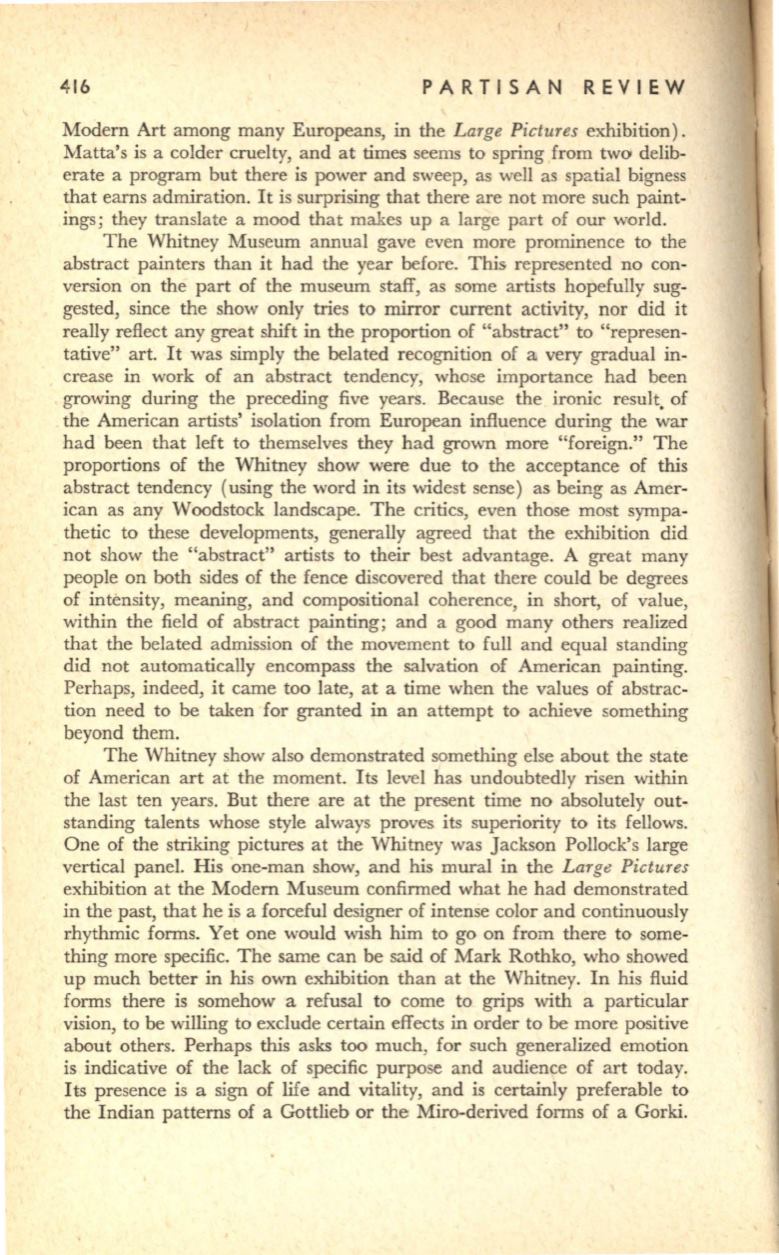
416
PARTISAN REVIEW
Modern Art among many Europeans, in the
Large Pictures
exhibition).
Matta's is a colder cruelty, and at times seems to spring from two delib–
erate a program but there is power and sweep, as well as spatial bigness
that earns admiration. It is surprising that there are not more such paint–
ings; they translate a mood that makes up a large part of our world.
The Whitney Museum annual gave even more prominence to the
abstract painters than it had the year before. This represented no con–
version on the part of the museum staff, as some artists hopefully sug–
gested, since the show only tries to mirror current activity, nor did it
really reflect any great shift in the proportion of "abstract" to "represen–
tative" art. It was simply the belated recognition of a very gradual in–
crease in work of an abstract tendency, whose importance had been
growing during the preceding five years. Because the ironic result. of
the American artists' isolation from European influence during the war
had been that left to themselves they had grown more "foreign." The
proportions of the Whitney show were due to the acceptance of this
abstract tendency (using the word in its widest sense) as being as Amer–
ican as any Woodstock landscape. The critics, even those most sympa–
thetic to these developments, generally agreed that the exhibition did
not show the "abstract" artists to their best advantage. A great many
people on both sides of the fence discovered that there could be degrees
of intensity, meaning, and compositional coherence, in short, of value,
within the field of abstract painting; and a good many others realized
that the belated admission of the movement to full and equal standing
did not automatically encompass the salvation of American painting.
Perhaps, indeed, it came too late, at a time when the values of abstrac–
tion need to be taken for granted in an attempt to achieve something
beyond them.
The Whitney show also demonstrated something else about the state
of American art at the moment. Its level has undoubtedly risen within
the last ten years. But there are at the present time no absolutely out–
standing talents whose style always proves its superiority to its fellows.
One of the striking pictures at the Whitney was Jackson Pollock's large
vertical panel. His one-man show, and his mural in the
Large Pictures
exhibition at the Modern Museum confirmed what he had demonstrated
in the past, that he is a forceful designer of intense color and continuously
rhythmic forms. Yet one would wish him to go on from there to some–
thing more specific. The same can be said of Mark Rothko, who showed
up much better in his own exhibition than at the Whitney. In his fluid
forms there is somehow a refusal to come to grips with a particular
vision, to be willing to exclude certain effects
in
order to
be
more positive
about others. Perhaps this asks too much, for such generalized emotion
is indicative of the lack of specific purpose and audience of art today.
Its presence is a sign of life and vitality, and is certainly preferable to
the Indian patterns of a Gottlieb or the Mira-derived forms of a Gorki.


